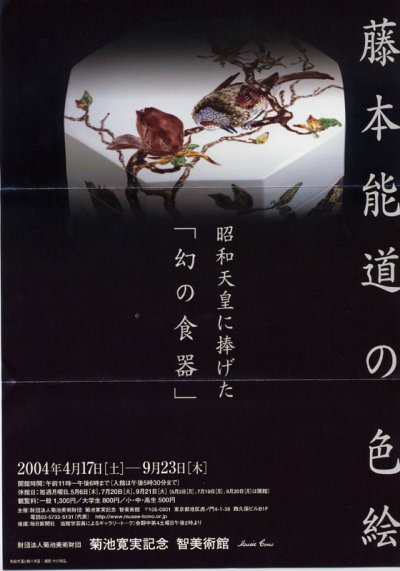|

Click here for
index to all
Yellin stories for
The Japan Times
LEARN MORE
Musée Tomo
Museum Review
Porcelain
Guidebook

Yellin's gallery
sells pieces from
the kilns of Japan's
finest potters
|
|
|
The Emperor's Phantom Porcelain Set
By ROBERT YELLIN
for the Japan Times, May 12, 2004
|
|
Fujimoto Yoshimichi Overglaze Porcelain runs until Sept. 23 at Musée Tomo, Nishikubo Bldg. B1F, Toranomon 4-1-35, behind the Okura Hotel.
TEL: (03) 5733-5131
Open Tuesday - Sunday
11 am to 6 pm
Admission 1,300 yen
MAP TO MUSEE TOMO
(outside link; new window)
|
|
|
|
|
|
|
Rarely, if ever, has a dinner set taken on such a mysterious aura as the maboroshi (phantom) porcelain service made by the late Fujimoto Yoshimichi (1919 to 1992). Used only once and then, for reasons that remain enigmatic, hidden away for years, it comprises 230 pieces, enough to serve 15 diners. Only two, though, have ever used the set -- the Showa Emperor and Empress, who dined off it in 1976. The dinner service was then sentenced to a dark and fabled existence -- until now.
Showing at the wonderful Musée Tomo in Tokyo until Sept. 23 is an exhibition -- "Yoshimichi Fujimoto Overglaze Porcelain: The Phantom Dinner Set for the Showa Emperor" -- that gives visitors the chance to see this historical set along with other Fujimoto masterpieces. All are enchanting.
Fujimoto's career was twofold: besides being a ceramic artist par excellence, he was also an extremely influential teacher at the Tokyo University of Fine Arts. The impact he made in the latter role is clearly evident from the works of his students, now established potters, some of whom are regrettably so in thrall to their late master that they produce dull and lifeless Fujimoto copies.
Fujimoto's work is bewitching in the way images of nature seem to burst off the porcelain forms with stunning clarity. Standing before the magical pots he made at the end of his career, we enter a ceramic world never seen before: birds perch in apricot branches or fly over streams in which fallen maple leaves flow, all depicted with startling realism. To achieve this, Fujimoto devised his own techniques of layering enamel colors over each other to create an effect like that of watercolor.
Meanwhile, early in his career, Fujimoto used a stoneware body, painted over with fanciful, lively designs. He switched to porcelain in 1973, as it was better suited for his enamel technique and the designs he wished to create. In March 1973, he embarked upon a porcelain-testing phase that would last more than a year. He used a color scheme of red, yellow, green, dark blue and purple known as gosai, which is the standard palette for Ko-Kutani porcelain. In 1976, at the request of Kikuchi Tomo -- the museum is named after her -- Fujimoto was commissioned to make the maboroshi set.
One would imagine an out-of-the-ordinary menu for the Imperial couple, yet what was served on Fujimoto's dishes was quite mundane: an appetizer of sliced salmon, consomme soup, shrimp pie -- and custard pudding for dessert.
Fujimoto said years after the set's completion that it "was and would be the most unforgettable work of my life."
Great as this set is, though, it is surely not the defining moment of Fujimoto's career. That would have to be his development of a glaze style called yubyokasai, in which he painted on a pure white porcelain body. This technique gives a three-dimensional, painterly depth to his nature motifs that defy the clay medium. We are able to stand on the shore with a snowy heron, or perch on a branch with a wagtail as it stares out to a white infinity on a jar or plate.
Fujimoto used yubyokasai from 1983 onward; in 1986 it earned him the designation of Living National Treasure (LNT) -- one of the few such honors bestowed in the pottery world in the last 20 years that I wholeheartedly agree with. In this generous and blessed artist we find the best of Japan's ceramic art combined with his enlightened gift of teaching.
"Yoshimichi Fujimoto Overglaze Porcelain" runs till Sept. 23 at Musée Tomo, Nishikubo Bldg. B1F, Toranomon 4-1-35, behind the Okura Hotel; (03) 5733-5131. For a detailed map, see www.musee-tomo.or.jp/usage.html Open Tuesday-Sunday, 11 a.m-6 p.m.; admission 1,300 yen.
The Japan Times: May 12, 2004
(C) All rights reserved

Musée Tomo Exhibition Flyer
For the Fujimoto Yoshimichi Exhibit

Musée Tomo Exhibition Flyer
For the Fujimoto Yoshimichi Exhibit
LEARN MORE
|
|
|